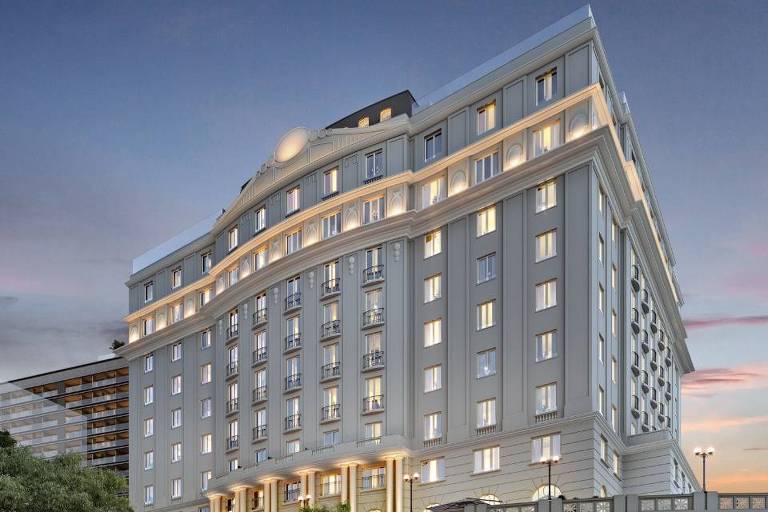The crisis in the hotel sector aggravated by the pandemic has given a new destination to classic buildings, without leaving aside their original characteristics.
With the flight of tourists and without events, congresses and seminars for two years, around 7,000 hotels and inns closed permanently in the country.
Entrepreneurs in the real estate market see the opportunity behind closed doors to transform properties into homes with history and attractive for investments.
The transformation is through the process of revitalization of old buildings, known as retrofit, and supported by new legislation.
In Rio de Janeiro, where the supply of hotel rooms tripled before the World Cup and the Olympics, the trend has reached iconic buildings.
After the sporting tournaments ended, rooms were left over, and hotels began to close. Social isolation in 2020 was the last straw for the sector.
At the beginning of the pandemic, the first reinforced concrete building in South America and the first and most famous five-star in Brazil closed its activities.
Built exactly 100 years ago, Hotel Glória was purchased in 2008 by the EBX Group, owned by businessman Eike Batista, for R$80 million. The promise was to renovate the building for the 2014 World Cup.
The BNDES (National Bank for Economic and Social Development) granted a millionaire loan for the works in 2010, but the renovation was never completed.
Now, one of Rio’s postcards is undergoing a retrofit to have 266 residential apartments ranging from 70 m² to 314 m², in addition to four stores on the ground floor.
Traditional Hotel Glória before and after

According to the real estate fund Opportunity Imobiliário and SIG Engenharia, responsible for the construction and development, the investment in the Glória retrofit is R$ 400 million. R$ 100 million for the land, R$ 50 million for the decoration and R$ 250 million for the works that will preserve the neoclassical facade.
The apartments are expected to be delivered in 2026. With an average price per m² valued at R$17,000, the smallest unit will cost R$1.2 million.
In the neighborhood next to Glória, D2J Construtora bought Hotel Flamengo Palace to transform it into a residential with 42 units starting at R$580,000 each.
The deal was only possible after local legislation allowed the construction of properties smaller than 40 m² and the change in use of abandoned buildings, according to Daniel Afonso, director of D2J.
“Hotel rooms are easier to transform into studios, a segment with high demand, especially among investors in rental properties”, he says.
The 1970s building gained balconies, a digital concierge and a rooftop overlooking the Guanabara Bay.
Before and after the retrofit at the Saint George hotel


“There are many hotels that are not from chains with difficulty to resist in the hotel business and that are in central regions, very well located”, says Maxime Barkatz, founder of Ilion Partners, specialized in renovation of old buildings in downtown São Paulo.
“Vacation rentals have created more pressure on hotels. Added to this is the fact that there are a lot of people who don’t recognize themselves in new construction buildings.”
Barkatz says that, in São Paulo, there is a strong movement for housing in the center. “Companies are leaving, and people are moving downtown,” she says.
The company transformed the old Jaguar hotel, on Avenida Duque de Caxias, into a student residence.
And on Marquês de Paranaguá street, the LOI Suites hotel is undergoing a retrofit to become a residential building for rent.
“We try to keep as much of the structure, architecture, facade, materials as possible, to rescue the strength of the buildings and try accessible products”, says Barkatz.
Preserving the original aspects of the environment and modernizing its infrastructure is what differentiates a retrofit from a renovation.
According to Lígia Marta Mackey, vice-president in the exercise of the presidency of Crea-SP, the building needs to adapt installations, such as electrical ones, to current requirements and in order to extend its useful life.
“A property built decades ago will need to remake the electrical charge to accommodate the current needs of residents, such as air conditioning, outlets, wi-fi.”
Roberto Racanicchi, assistant coordinator of the Specialized Chamber of Civil Engineering of Crea-SP, says that the high risk of fire in most of the buildings in the central region of São Paulo exists due to the lack of correct reforms.
“It is always necessary to have a qualified, specialized professional, so as not to overload the structure by changing the function of the property, not to impact neighboring buildings and to have the fire department’s inspection report up to date. A project is needed.”
Although they are already built, the time between the purchase of hotels that will undergo retrofit and the launch of residential apartments on the market is not much shorter than that of a new building. According to Barkatz, it takes, on average, a year for the city to analyze and approve the change of function of a property. And the works can last more than six months.
The time for an enterprise built from scratch to reach the consumer is now two to three years after the purchase of the land.
Investing in hotels is easier than in other types of commercial real estate, as the layout of the structure is more similar to that of residential buildings.
“The area may be small for hotels, but for vacation homes it is ideal”, says Maxime Barkatz.
“There is a lot of room to grow,” he says.
Hotel industry associations estimate that pre-pandemic occupancy levels in the country will only be recovered in 2023.
I have over 8 years of experience in the news industry. I have worked for various news websites and have also written for a few news agencies. I mostly cover healthcare news, but I am also interested in other topics such as politics, business, and entertainment. In my free time, I enjoy writing fiction and spending time with my family and friends.










